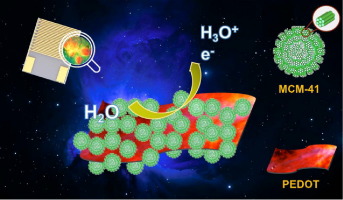当前位置:
X-MOL 学术
›
J. Colloid Interface Sci.
›
论文详情
Our official English website, www.x-mol.net, welcomes your
feedback! (Note: you will need to create a separate account there.)
Capacitive humidity sensors based on mesoporous silica and poly(3,4-ethylenedioxythiophene) composites.
Journal of Colloid and Interface Science ( IF 9.4 ) Pub Date : 2020-01-17 , DOI: 10.1016/j.jcis.2020.01.062 Rongrong Qi 1 , Tong Zhang 2 , Xin Guan 2 , Jianxun Dai 2 , Sen Liu 2 , Hongran Zhao 2 , Teng Fei 1
Journal of Colloid and Interface Science ( IF 9.4 ) Pub Date : 2020-01-17 , DOI: 10.1016/j.jcis.2020.01.062 Rongrong Qi 1 , Tong Zhang 2 , Xin Guan 2 , Jianxun Dai 2 , Sen Liu 2 , Hongran Zhao 2 , Teng Fei 1
Affiliation

|
Owing to the outstanding dielectric properties derived from the conjugated π-electron systems, conjugated polymers have been explored and developed in capacitive humidity sensors for a few decades. In this work, a series of composites - mesoporous silica and semiconducting polymers - MCM-41 (MCM, Mesoporous Crystalline Material)/PEDOT (poly(3,4-ethylenedioxythiophene)) were chemically obtained by in-situ polymerization at 0 °C, while the amounts of PEDOT were adjusted by different evaporation times of EDOT (3,4-ethylenedioxythiophene) in the porous MCM-41 film. Additionally, it was able to modulate both the dielectricity and porosity of the composites via this convenient approach. The obtained capacitive humidity sensors based on MCM-41/PEDOT composites exhibit much better sensing performance than their bulk counterparts, with wider humidity sensing range, higher sensitivity and much faster response speed.
中文翻译:

基于介孔二氧化硅和聚(3,4-乙撑二氧噻吩)复合材料的电容式湿度传感器。
由于源自共轭π电子系统的出色介电性能,共轭聚合物已在电容式湿度传感器中进行了数十年的研究和开发。在这项工作中,在0°C下通过原位聚合化学合成了一系列复合材料-介孔二氧化硅和半导体聚合物-MCM-41(MCM,介孔晶体材料)/ PEDOT(聚(3,4-乙撑二氧噻吩)),同时通过多孔MCM-41膜中EDOT(3,4-乙撑二氧噻吩)的不同蒸发时间来调节PEDOT的量。另外,通过这种方便的方法,它能够调节复合材料的介电常数和孔隙率。所获得的基于MCM-41 / PEDOT复合材料的电容式湿度传感器的感测性能要优于其同类产品,
更新日期:2020-01-17
中文翻译:

基于介孔二氧化硅和聚(3,4-乙撑二氧噻吩)复合材料的电容式湿度传感器。
由于源自共轭π电子系统的出色介电性能,共轭聚合物已在电容式湿度传感器中进行了数十年的研究和开发。在这项工作中,在0°C下通过原位聚合化学合成了一系列复合材料-介孔二氧化硅和半导体聚合物-MCM-41(MCM,介孔晶体材料)/ PEDOT(聚(3,4-乙撑二氧噻吩)),同时通过多孔MCM-41膜中EDOT(3,4-乙撑二氧噻吩)的不同蒸发时间来调节PEDOT的量。另外,通过这种方便的方法,它能够调节复合材料的介电常数和孔隙率。所获得的基于MCM-41 / PEDOT复合材料的电容式湿度传感器的感测性能要优于其同类产品,











































 京公网安备 11010802027423号
京公网安备 11010802027423号